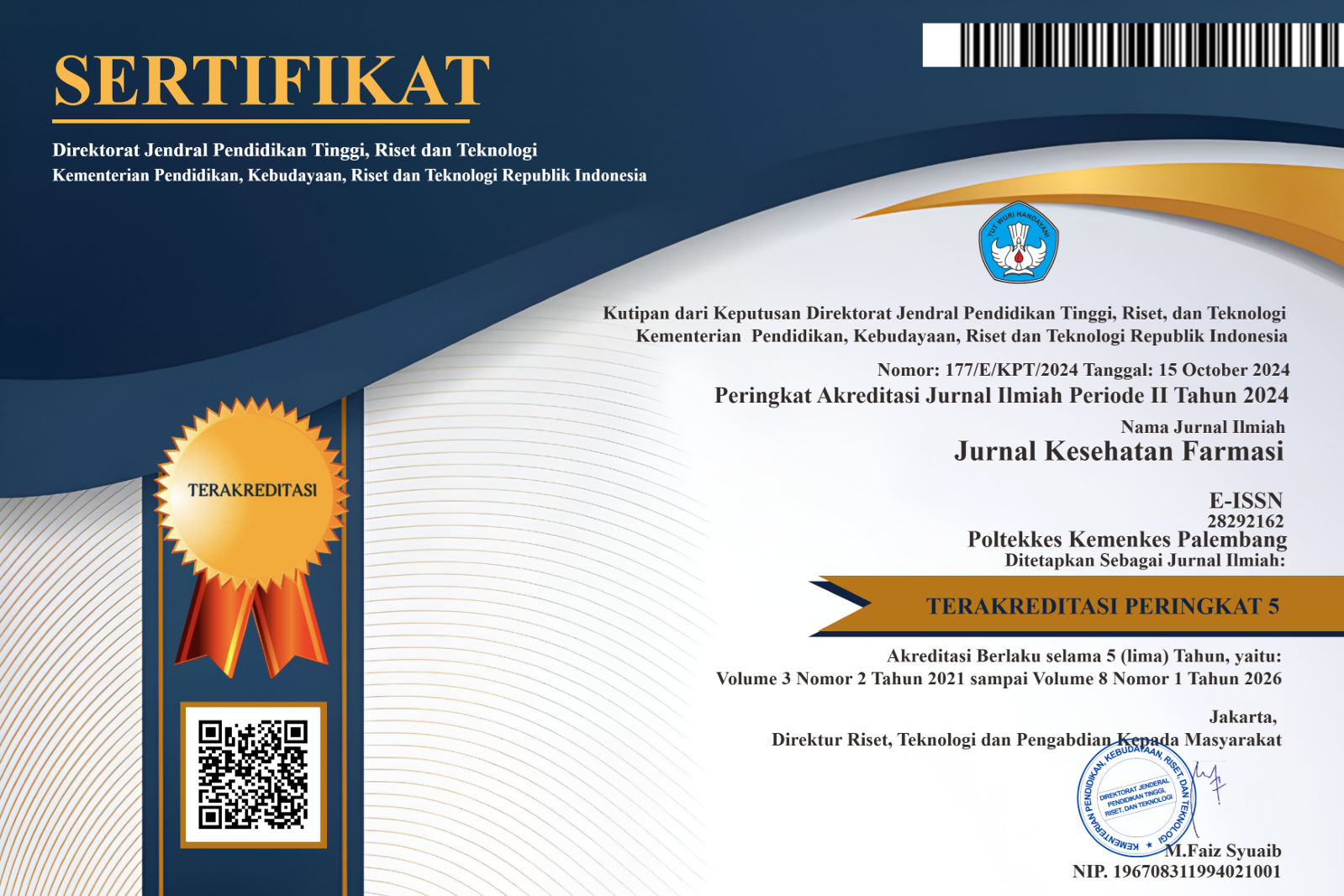Formulasi dan Evaluasi Sediaan Gel Ekstrak Metanol Kulit Buah Pisang Raja (Musa X paradisiaca AAB) dengan Variasi Hpmc Sebagai Gelling Agent
Abstract
ABSTRAK
Latar Belakang : Gel adalah sediaan yang mudah menyerap pada kulit. Kestabilan fisik gel sangat dipengaruhi oleh gelling agent, salah satunya adalah HPMC karena dapat memiliki daya lepas obat yang baik. Zat aktif yang digunakan adalah kulit buah pisang raja (Musa X paradisiaca AAB) yang memiliki aktivitas antoksidan tinggi sehingga dapat mencegah penuaan dini. Penelitian ini bertujuan untuk mengetahui konsentrasi HPMC yang optimal untuk menghasilkan gel yang stabil dan memenuhi syarat..
Metode: penelitian ini menggunakan metode eksperimental, dimana ekstrak metanol kulit buah pisang raja (Musa X paradisiaca AAB) digunakan sebagai zat aktif dengan kadar 3,8% yang diformulasikan menjadi sediaan gel dengan memvariasikan konsentrasi HPMC. Variasi konsentrasi HPMC yang digunakan adalah 2% pada formula kontrol, 2% pada formula I, 3% pada formula II dan 4% pada formula III. Kemudan dilakukan evaluasi sediaan pada penyimpanan suhu kamar dan uji dipercepat (cycling test) meliputi pH, daya sebar, homogenitas, sineresis/swelling, warna, bau dan iritasi kulit.
Hasil: Berdasarkan hasil yang didapat, pH dan daya sebar sediaan pada uji penyimpanan suhu kamar dan uji dipercepat (cycling test) mengalami penurunan namun masih memenuhi syarat kecuali pada formula III jika ditinjau dari pengujian daya sebar pada hari ke-21 dan ke-28 tidak memenuhi syarat. Ditinjau dari sineresis/swelling, homogenitas, warna, bau dan iritasi kulit, semua formula memenuhi syarat selama penyimpanan suhu kamar dan uji dipercepat (cycling test).
Kesimpulan: Ekstrak kulit buah pisang raja (Musa X paradisiaca AAB) dapat diformulasikan menjadi sediaan gel yang stabil dan memenuhi persayratan yang diramalkan dapat bertahan selama 12 bulan penyimpanan. Formula yang paling optimal yaitu dengan variasi konsentrasi HPMC 3%.
Kata Kunci: Gel, ekstrak metanol kulit buah pisang raja (Musa X paradisiaca AAB), gelling agent, HPMC
ABSTRAC
Background: Gel is a preparation that is easy to absorb on the skin. The physical stability of the gel is highly relied on by gelling agents, the one of which is HPMC because it has good drug release power. The active substance used is the skin of plantain (Musa X paradisiaca AAB) which has high antioxidant activity so it can prevent premature aging. This study aims to measure the optimal concentration of HPMC to produce a stable and eligible gel.
Methods: The study used an experimental method, in which the methanol extract of plantain fruit peel (Musa X paradisiaca AAB) was used as an active substance with a level of 3.8% which was formulated into a gel preparation by varying the concentration of HPMC. The variation of the HPMC concentration used was 2% in the control formula, 2% in formula I, 3% in formula II and 4% in formula III. Then, the preparation was evaluated at room temperature storage and an accelerated test (cycling test) including pH, dispersibility, homogeneity, syneresis / swelling, color, odor and skin irritation.
Results: Based on the results obtained, the pH and dispersibility of the preparations in the room temperature storage test and cycling test decreased but they were still valid except for formula III when viewed from the spreadability test on the 21st and 28th day. . In terms of syneresis / swelling, homogeneity, color, odor and skin irritation, all formulas were eligible during room temperature storage and cycling test.
Conclusion: Plantain fruit peel extract (Musa X paradisiaca AAB) can be formulated into a gel preparation that is stable and meets the requirements predicted to last for 12 months of storage. The most optimal formula is by varying the concentration of HPMC 3%.
Keywords: Gel, methanol extract of plantain fruit peel (Musa X paradisiaca AAB), gelling agent, HPMC
Copyright (c) 2021 JKPharm Jurnal Kesehatan Farmasi

This work is licensed under a Creative Commons Attribution-ShareAlike 4.0 International License.
Authors who publish with this journal agree to the following terms:
- Authors retain copyright and grant the journal right of first publication with the work simultaneously licensed under a Creative Commons Attribution License that allows others to share the work with an acknowledgement of the work's authorship and initial publication in this journal.
- Authors are able to enter into separate, additional contractual arrangements for the non-exclusive distribution of the journal's published version of the work (e.g., post it to an institutional repository or publish it in a book), with an acknowledgement of its initial publication in this journal.
- Authors are permitted and encouraged to post their work online (e.g., in institutional repositories or on their website) prior to and during the submission process, as it can lead to productive exchanges, as well as earlier and greater citation of published work














